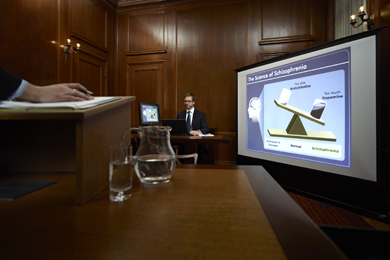Astound the Court: Vital Elements of a Powerful Test Presentation
Essential components such as understanding the target market, crafting an engaging story, and grasping verbal and non-verbal communication are critical components of an efficient discussion. As these elements intertwine, they form a natural method that not just informs yet also involves jurors on several degrees.

Understanding Your Target Market
Understanding your target market is a critical aspect of efficient trial presentation. An effective discussion rests on the capability to grasp the demographics, worths, and proneness of jurors. This comprehension notifies how disagreements are framed, evidence exists, and emotional appeals are crafted, making sure that the message reverberates with the jurors on an individual level.
Study suggests that jurors come from diverse histories and might have varying levels of comprehending pertaining to legal procedures. Furthermore, recognizing the jurors' prospective biases and life experiences permits the test speaker to anticipate objections and address issues proactively.
Reliable trial presentation additionally includes observing jurors' reactions throughout the process. Engaging with jurors as individuals rather than a cumulative device is vital in fostering a strong connection in the court room.

Crafting a Compelling Story
Crafting a compelling story is essential in leading jurors via the intricacies of an instance. A well-structured story not just simplifies complex lawful ideas but also engages jurors on a psychological degree, making the info extra relatable and memorable.
To accomplish this, lawyers ought to begin by identifying the core message they want to share. This message must reverberate with the jurors' worths and experiences, promoting a connection that goes beyond plain facts. The narrative ought to unfold logically, presenting events in a clear series to prevent confusion. This sequential strategy can aid jurors comply with the progression of events, stressing domino effect.
Incorporating human components-- such as personal tales or narratives-- can further improve the story's effect. These components evoke empathy, allowing jurors to imagine the repercussions of the instance on realities. Furthermore, utilizing a regular theme throughout the presentation reinforces the major disagreement, making it less complicated for jurors to retain crucial points.
Inevitably, an engaging story changes a trial discussion from a plain recitation of realities right into a convincing tale that astounds the jury, motivating them to deliberate with both reason and feeling.
Utilizing Visual Aids
Integrating aesthetic help into a trial discussion can significantly boost jurors' comprehension and retention of details. Visual products such as graphes, diagrams, pictures, and video clips can change complicated lawful concepts and evidence right into quickly digestible layouts. By engaging numerous detects, these help allow jurors to envision the instance's crucial elements, making it Recommended Reading less complicated for them to adhere to along and realize detailed details.
Moreover, properly designed aesthetic help can stress critical factors and highlight connections in between different items of proof. For instance, timelines can efficiently highlight the sequence of occasions, while annotated photos can clear up specific information relevant to the case. This not just help in understanding however likewise strengthens the story presented by the lawyer.
Extremely complex or messy visuals might overwhelm jurors and detract from the message. Ultimately, reliable visual communication can be an effective tool in convincing jurors and assisting them get to informed verdicts.
Grasping Verbal Communication
Reliable verbal communication is important in a trial presentation, as it serves as the main methods via which attorneys communicate you can try these out their debates and attach with jurors. Simpleness in language fosters understanding and assists jurors grasp intricate concerns presented during the trial.
Additionally, tone and pacing substantially effect how messages are received. A confident tone shares authority, while proper pacing enables jurors to take in info without feeling bewildered. Lawyers must also vary their vocal inflections to stress bottom lines and keep jurors' passion throughout the presentation.
Additionally, the company of spoken arguments is essential. Structuring the narrative rationally and coherently assists jurors adhere to the attorney's line of reasoning, making it simpler for them to keep essential details. Using persuasive strategies, such as storytelling, can additionally improve the click for more emotional vibration of the disagreements offered, consequently producing a much more extensive connection with jurors.
Eventually, grasping verbal communication not only reinforces an attorney's case yet likewise promotes trust and rapport with the court, considerably enhancing the opportunities of a desirable verdict.

Engaging With Body Language
Nonverbal interaction plays a vital duty in trial discussions, frequently conveying messages that words alone can not express. Body language, encompassing gestures, stance, face expressions, and eye get in touch with, significantly affects how jurors regard the reliability and sincerity of the presenter. A certain stance, with shoulders back and an open stance, can instill trust fund, while closed-off body movement may recommend defensiveness or unpredictability.

Faces should mirror the feelings connected with the case, reinforcing the narrative existing. An honest expression during a touching moment can generate compassion and enhance the psychological allure. Ultimately, understanding body movement is crucial for reliable test discussions, as it boosts verbal communication and develops a compelling presence that reverberates with the jury.
Final Thought
Finally, captivating the jury necessitates a critical method that incorporates comprehending the audience, crafting an engaging narrative, using visual help, grasping verbal communication, and involving with body movement. Each aspect plays a vital duty in developing a powerful test discussion that reverberates with jurors on both psychological and intellectual degrees (trial presentation). By integrating these elements properly, attorneys can substantially enhance their ability to persuade and influence jury decision-making